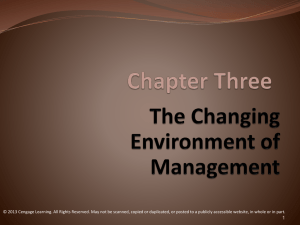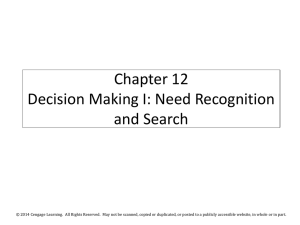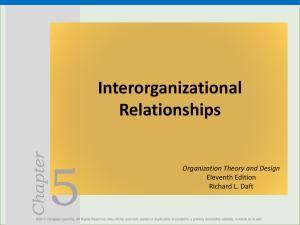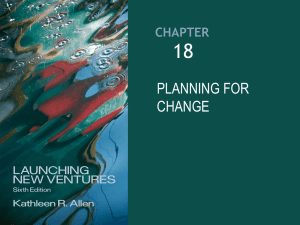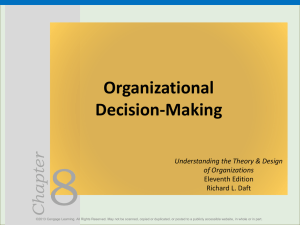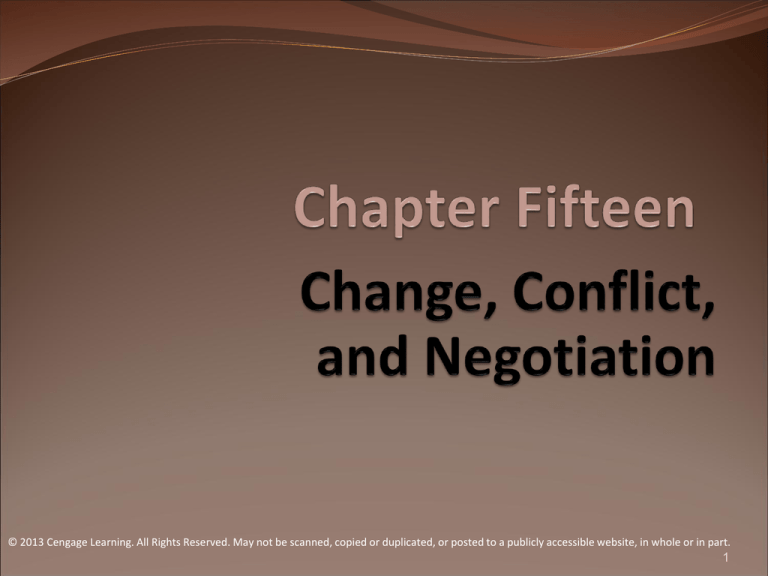
© 2013 Cengage Learning. All Rights Reserved. May not be scanned, copied or duplicated, or posted to a publicly accessible website, in whole or in part.
1
Chapter Objectives
Identify and describe four types of organizational
change according to the Nadler-Tushman model.
Explain how people tend to respond differently to
changes they like and those they dislike.
List at least six reasons why employees resist change
and discuss what management can do about resistance
to change.
Describe how the unfreezing-change-refreezing
metaphor applies to organization development (OD).
© 2013 Cengage Learning. All Rights Reserved. May not be scanned, copied or duplicated, or posted to a publicly accessible website, in whole or in part.
2
Chapter Objectives (cont’d)
Describe tempered radicals and identify the 5Ps in the
checklist for grassroots change agents.
Contrast competitive and cooperative conflict styles.
Identify and describe five conflict resolution
techniques.
Identify and describe the elements of effective
negotiation and explain the advantage of added value
negotiating (AVN).
© 2013 Cengage Learning. All Rights Reserved. May not be scanned, copied or duplicated, or posted to a publicly accessible website, in whole or in part.
3
Change: Organizational &
Individual Perspectives
Types of Organizational Change
Anticipatory changes: Planned changes based on
expected situations
Reactive changes: Changes made in response to
unexpected situations
Incremental changes: Subsystem adjustments required
to keep the organization on course
Strategic changes: Altering the overall shape or
direction of the organization
© 2013 Cengage Learning. All Rights Reserved. May not be scanned, copied or duplicated, or posted to a publicly accessible website, in whole or in part.
4
Figure 15.1: Four Types
of Organizational Change
© 2013 Cengage Learning. All Rights Reserved. May not be scanned, copied or duplicated, or posted to a publicly accessible website, in whole or in part.
5
Organizational & Individual Perspectives
Tuning
The most common, least intense, and least risky type
of change
Also known as preventive maintenance and kaizen
(continuous improvement)
Key is to actively anticipate and avoid problems rather
than waiting for something to go wrong
Adaptation
Incremental changes that are in reaction to external
problems, events, or pressures
© 2013 Cengage Learning. All Rights Reserved. May not be scanned, copied or duplicated, or posted to a publicly accessible website, in whole or in part.
6
Organizational & Individual Perspectives
Reorientation
Change that is anticipatory and strategic in scope and
causes the organization to be significantly redirected
Also called “frame bending” (Nadler and Tushman)
Re-Creation
Intense, risky, and decisive change that reinvents the
organization
Also called “frame breaking” (Nadler and Tushman)
© 2013 Cengage Learning. All Rights Reserved. May not be scanned, copied or duplicated, or posted to a publicly accessible website, in whole or in part.
7
Individual Reactions to Change
Change happens on an individual level, even in the
workplace
How People Respond to Changes They Like
Three-stage process
Unrealistic optimism
Reality shock
Constructive direction
© 2013 Cengage Learning. All Rights Reserved. May not be scanned, copied or duplicated, or posted to a publicly accessible website, in whole or in part.
8
Figure 15.2: How People Tend
to Respond to Changes They Like
© 2013 Cengage Learning. All Rights Reserved. May not be scanned, copied or duplicated, or posted to a publicly accessible website, in whole or in part.
9
Individual Reactions to Change
(cont’d)
On-the-Job changes generally are more feared than
welcomed
How People Respond to Changes They Fear and
Dislike
Stages
Getting off on the wrong track
Laughing it off
Growing self-doubt
Buying in
Constructive direction
© 2013 Cengage Learning. All Rights Reserved. May not be scanned, copied or duplicated, or posted to a publicly accessible website, in whole or in part.
10
Figure 15.3: How People Respond
to Changes They Fear and Dislike
© 2013 Cengage Learning. All Rights Reserved. May not be scanned, copied or duplicated, or posted to a publicly accessible website, in whole or in part.
11
Table 15.1: How to Help Individuals Deal with
Change: A Contingency Approach
© 2013 Cengage Learning. All Rights Reserved. May not be scanned, copied or duplicated, or posted to a publicly accessible website, in whole or in part.
12
Table 15.1: How to Help Individuals Deal with
Change: A Contingency Approach (cont.)
© 2013 Cengage Learning. All Rights Reserved. May not be scanned, copied or duplicated, or posted to a publicly accessible website, in whole or in part.
13
Why Do Employees Resist Change?
Surprise
Unannounced significant changes threaten employees’
sense of balance in the workplace.
Inertia
Employees have a desire to maintain a safe, secure, and
predictable status quo.
Misunderstanding/Ignorance/Lack of Skills
Without introductory or remedial training, change
may be perceived negatively.
© 2013 Cengage Learning. All Rights Reserved. May not be scanned, copied or duplicated, or posted to a publicly accessible website, in whole or in part.
14
Why Do Employees Resist Change?
(cont’d)
Emotional Side Effects
Forced acceptance of change can create a sense of
powerlessness, anger, and passive resistance to change.
Lack of Trust
Promises of improvement mean nothing if employees
do not trust management.
Fear of Failure
Employees are intimidated by change and doubt their
abilities to meet new challenges.
© 2013 Cengage Learning. All Rights Reserved. May not be scanned, copied or duplicated, or posted to a publicly accessible website, in whole or in part.
15
Why Do Employees Resist Change?
(cont’d)
Personality Conflicts
Managers who are disliked by their employees are
poor conduits for change.
Poor Timing
Other events can conspire to create resentment
about a particular change.
Lack of Tact
Not showing sensitivity to feelings can create
resistance to change.
© 2013 Cengage Learning. All Rights Reserved. May not be scanned, copied or duplicated, or posted to a publicly accessible website, in whole or in part.
16
Why Do Employees Resist Change?
(cont’d)
Threat to Job Status/Security
Employees worry that change threatens their job or
security.
Breakup of Work Group
Changes can tear apart established on-the-job social
relationships.
Passive-Aggressive Organizational Culture
The more things change, the more they stay the same.
Competing Commitments
Change can disrupt employees in their pursuit of other
goals.
© 2013 Cengage Learning. All Rights Reserved. May not be scanned, copied or duplicated, or posted to a publicly accessible website, in whole or in part.
17
Strategies for Overcoming
Resistance to Change
Strategies for Overcoming Resistance to Change
Education and communication
Participation and involvement
Facilitation and support
Negotiation and agreement
Manipulation and co-optation
Explicit and implicit coercion
© 2013 Cengage Learning. All Rights Reserved. May not be scanned, copied or duplicated, or posted to a publicly accessible website, in whole or in part.
18
Table 15.2: Dealing with Resistance to Change
© 2013 Cengage Learning. All Rights Reserved. May not be scanned, copied or duplicated, or posted to a publicly accessible website, in whole or in part.
19
Making Change Happen
Two Approaches to Organizational Change
Organization Development (OD)
A planned change programs intended to help people and
organizations function more effectively
Formal top-down approach
Grassroots change
Unofficial and informal bottom-up approach
© 2013 Cengage Learning. All Rights Reserved. May not be scanned, copied or duplicated, or posted to a publicly accessible website, in whole or in part.
20
Objectives of OD
Deepen sense of organizational purpose.
Strengthen interpersonal trust.
Encourage problem solving rather than avoidance.
Develop a satisfying work experience.
Supplement formal authority with knowledge and
skill-based authority.
Increase personal responsibility for planning and
implementing.
Encourage willingness to change.
© 2013 Cengage Learning. All Rights Reserved. May not be scanned, copied or duplicated, or posted to a publicly accessible website, in whole or in part.
21
The OD Process
Unfreezing, Change, Refreezing (Kurt Lewin)
Unfreezing: Neutralizing resistance by preparing
people for change
Change: Introduction of the intervention
Refreezing: Systematically following a change program
for lasting results
© 2013 Cengage Learning. All Rights Reserved. May not be scanned, copied or duplicated, or posted to a publicly accessible website, in whole or in part.
22
Figure 15.4: A General Model of OD
© 2013 Cengage Learning. All Rights Reserved. May not be scanned, copied or duplicated, or posted to a publicly accessible website, in whole or in part.
23
Unofficial and Informal
Grassroots Change
Tempered Radicals
People who quietly try to change the dominant
organizational culture in line with their convictions
Guidelines for tempered radicals:
Think small for big results.
Be authentic.
Translate.
Don’t go it alone.
© 2013 Cengage Learning. All Rights Reserved. May not be scanned, copied or duplicated, or posted to a publicly accessible website, in whole or in part.
24
Figure 15.5:
The 5P Checklist for All Change Agents
© 2013 Cengage Learning. All Rights Reserved. May not be scanned, copied or duplicated, or posted to a publicly accessible website, in whole or in part.
25
Managing Conflict
Conflict
One person’s incompatible behaviors that make
another person’s actions less effective
Dealing with the Two Faces of Conflict
Competitive conflict: Parties pursuing directly opposite
(win-lose) goals
Cooperative conflict: A mutually reinforcing
experience (win-win) that serves the best interests of
both parties
© 2013 Cengage Learning. All Rights Reserved. May not be scanned, copied or duplicated, or posted to a publicly accessible website, in whole or in part.
26
Figure 15.6: Competitive
Versus Cooperative Conflict
© 2013 Cengage Learning. All Rights Reserved. May not be scanned, copied or duplicated, or posted to a publicly accessible website, in whole or in part.
27
Managing Conflict
(cont’d)
Conflict Trigger
Any factor that increases the chances of conflict
Conflict Triggers
Ambiguous or overlapping jurisdictions
Competition for scarce resources
Communication breakdowns
Time pressure
Unreasonable standards, rules, policies, or procedures
Personality clashes
Status differentials
Unrealized expectations
© 2013 Cengage Learning. All Rights Reserved. May not be scanned, copied or duplicated, or posted to a publicly accessible website, in whole or in part.
28
Managing Conflict
(cont’d)
Resolving Conflict
Doing nothing is usually not a viable option.
Conflict Resolution Techniques
Problem solving
Superordinate goals
Compromise
Forcing
Smoothing
© 2013 Cengage Learning. All Rights Reserved. May not be scanned, copied or duplicated, or posted to a publicly accessible website, in whole or in part.
29
Negotiating
Negotiation
A decision-making process among interdependent
parties with different preferences
Common Types of Negotiation
Two-party negotiation (e.g., buyer and seller)
Third party negotiation (e.g., agents and arbitrators)
© 2013 Cengage Learning. All Rights Reserved. May not be scanned, copied or duplicated, or posted to a publicly accessible website, in whole or in part.
30
Negotiating
(cont’d)
Elements of Effective Negotiation
Adopting a win-win attitude
Understanding that a mutually beneficial agreement
addresses both parties’ interests
Knowing your BATNA (best alternative to a negotiated
agreement)
Your “bottom line” for accepting or rejecting offers
Identifying the bargaining zone
Negotiation is useless if both parties involved have no
common ground on which to maneuver during
bargaining.
© 2013 Cengage Learning. All Rights Reserved. May not be scanned, copied or duplicated, or posted to a publicly accessible website, in whole or in part.
31
Figure 15.7:
The Bargaining Zone for Negotiators
© 2013 Cengage Learning. All Rights Reserved. May not be scanned, copied or duplicated, or posted to a publicly accessible website, in whole or in part.
32
Negotiating
(cont’d)
Added Value Negotiating (AVN)
A practical five-step win-win process involving the
development of multiple deals
Clarify subjective and objective interests; seek common
ground.
Identify options and their marketplace values.
Design alternative deal packages that foster a creative
agreement.
Select a mutually acceptable deal that is feasible for both
parties.
Perfect the deal by strengthening relationships for future
negotiations.
© 2013 Cengage Learning. All Rights Reserved. May not be scanned, copied or duplicated, or posted to a publicly accessible website, in whole or in part.
33
Summary
The four types of change are tuning, adaptation, re-
orientation (frame bending), and re-creation (frame
breaking).
People who like a change tend to go through three stages:
unrealistic optimism, reality shock, and constructive
direction. When someone fears or dislikes a change, a more
complex process involving five stages tends to occur:
getting off on the wrong track, laughing it off, experiencing
growing self-doubt, buying in, and moving in a
constructive direction.
Employees resist change for many different reasons,
including (but not limited to) surprise, inertia, ignorance,
lack of trust, fear of failure, passive-aggressive behavior,
and competing commitments.
© 2013 Cengage Learning. All Rights Reserved. May not be scanned, copied or duplicated, or posted to a publicly accessible website, in whole or in part.
34
Summary
(cont’d)
Organization development (OD) is a systematic approach
to planned organizational change.
Unofficial and informal grassroots change can be initiated
by tempered radicals, who quietly follow their convictions
when trying to change the dominant organizational
culture.
Competitive conflict is characterized by a destructive cycle
of opposing goals, mistrust and disbelief, and avoidance of
discussion coupled with a win-lose attitude. In contrast,
cooperative conflict involves a constructive cycle of
cooperative goals, trust and reliance, and discussion
coupled with a win-win attitude.
© 2013 Cengage Learning. All Rights Reserved. May not be scanned, copied or duplicated, or posted to a publicly accessible website, in whole or in part.
35
Summary
(cont’d)
Conflict triggers can cause either constructive or
destructive conflict.
Three basic elements of effective negotiations are a
win-win attitude, a BATNA (best alternative to a
negotiated agreement) to serve as a negotiating
standard, and the calculation of a bargaining zone to
identify overlapping interests.
© 2013 Cengage Learning. All Rights Reserved. May not be scanned, copied or duplicated, or posted to a publicly accessible website, in whole or in part.
36
Terms to Understand
Anticipatory changes
Refreezing
Reactive changes
Tempered radicals
Incremental changes
Conflict
Strategic changes
Conflict trigger
Organization
Negotiation
development (OD)
Unfreezing
Bargaining zone
Added value
negotiating
© 2013 Cengage Learning. All Rights Reserved. May not be scanned, copied or duplicated, or posted to a publicly accessible website, in whole or in part.
37



